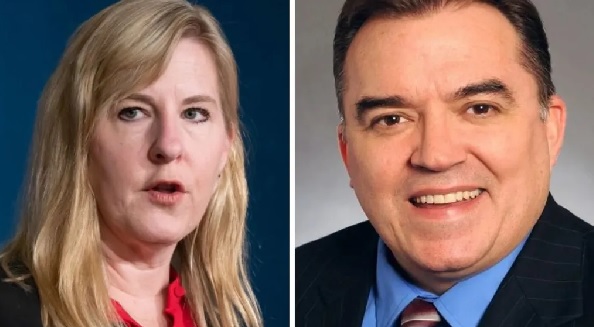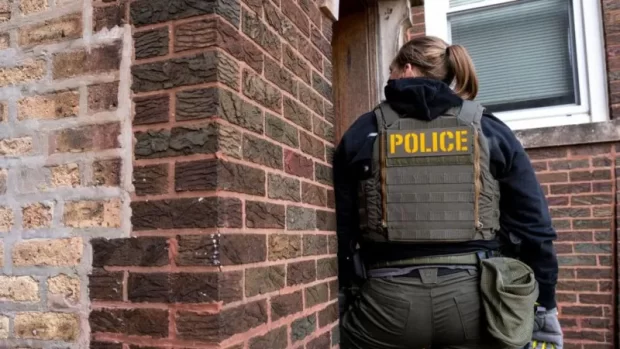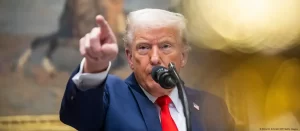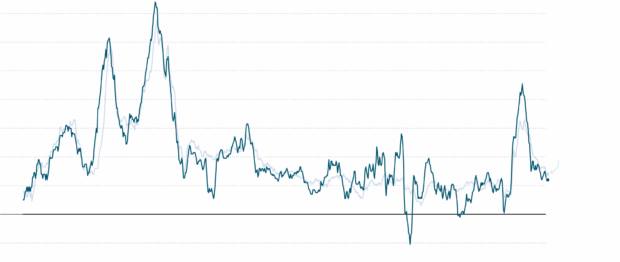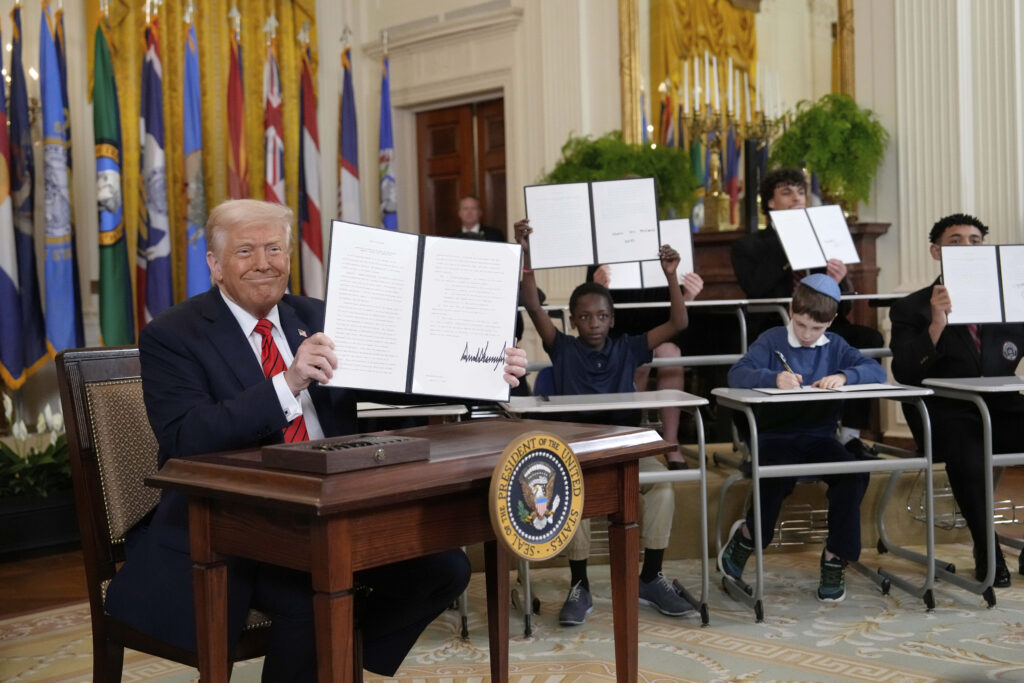

U.S. President Donald Trump has signed an executive order aimed at dismantling the Department of Education, fulfilling a campaign pledge and advancing a long-standing goal of many conservatives. The president criticized the agency for its “breath-taking failures” and pledged to return the federal funding it controls to individual states.
Trump expressed intentions to shut down the department as quickly as possible, but White House officials acknowledged that doing so would require an act of Congress. The move has already sparked legal challenges from opponents who seek to block the agency’s closure and the accompanying staff cuts, which were announced last week.
The Department of Education, established in 1979, manages student loans and oversees programs supporting low-income students. Despite the perception that the federal government runs U.S. schools, most school funding and curriculum decisions are made at the state and local levels. Federal funds contribute only about 13% of the total funding for primary and secondary schools in the U.S.
Trump’s administration has repeatedly criticized the department for what it sees as efforts to “indoctrinate” students with controversial racial, sexual, and political material. Trump argued that despite the U.S. spending more on education than any other country, American students’ performance ranks poorly.
During the signing ceremony, Trump, surrounded by children seated at school desks, further emphasized the need for restructuring the U.S. education system, claiming the country spends 5.4% of its GDP on education, which is higher than some but not all nations.
The department’s annual budget of $238 billion accounts for less than 2% of federal spending, but Trump’s administration has already begun reducing its workforce. Nearly 2,100 employees at the department are expected to be placed on leave starting Friday.
Despite facing challenges, the Trump administration hopes to shift the responsibility of education to state and local governments, allowing them to manage policies and funding more effectively. However, the American Federation of Teachers and other critics have condemned the plan, warning that it could harm children, particularly those from disadvantaged backgrounds.
The executive order calls for Linda McMahon, appointed as the department’s head, to lead the closure process while ensuring that critical education services remain uninterrupted.
This decision aligns with broader Republican criticisms of federal bureaucracy and represents a significant reshaping of U.S. education policy.
Tagged as:
Donald Trump executive order Federal Government US Education Department US education reform
About the author
62-Year-Old Businesswoman Remanded Over $13K Fraud
Nana Ama Nwurueze, a 62-year-old self-styled businesswoman, has been remanded by the Adabraka District Court in Accra for allegedly defrauding another businesswoman, Dorothy Asare, of $13,000. Nwurueze reportedly posed as a wealthy businesswoman with substantial properties, including Ohemaa Plaza in East Legon, fishing vessels in Takoradi, and a house at Airport, to deceive the complainant.The prosecution, led by Chief Inspector Apewa Achana, has charged Nwurueze with defrauding by false pretenses. She was arrested after a bench warrant was issued against her in December last year. Despite pleading not guilty, her bail application was denied, as the court determined she was a flight risk. The case was initially reported to the Airport Police Station in 2021, but attempts to arrest her were unsuccessful until her eventual arrest in March 2024. Following her arrest, she was granted police inquiry bail but went […]
Edem 4Style March 26, 2025
President Mahama Nominates 71 New DCEs Pending Approval
President John Mahama has nominated 71 new District Chief Executives (DCEs) across various districts in Ghana, pending approval by local Assembly members. This move is aimed at strengthening local governance as these executives are expected to play a crucial role in the management of their respective districts.An official statement detailing the nominations was signed by Dr. Callistus Mahama, the Secretary to the President, and addressed to the Minister of Local Government, Chieftaincy, and Religious Affairs.While most districts have their nominees, the nomination for the Kpando district is still pending. The new DCEs will need to be confirmed by the Assembly members in their respective districts before they officially take up their roles.
Edem 4Style March 26, 2025
FIC Freezes Accounts of Bills Micro-Credit Founder, Richard Nii Armah Quaye
The Financial Intelligence Centre (FIC) has frozen all accounts associated with Richard Nii Armah Quaye, the founder of Bills Micro-Credit. This includes accounts linked to Bills Micro-Credit, Quick Credit and Investment Micro-Credit, as well as an account of Romeo-Richlove Kweku Seshie, the Chief Executive Officer of Bills Micro-Credit.The action follows a letter from the FIC, in line with Section 56(1) of the Anti-Money Laundering Act, 2020 (Act 1044), and applies to all accounts connected to the named individuals, pending further instructions. The FIC’s role involves analyzing suspicious transactions related to money laundering, terrorist financing, and other financial crimes.The move comes after a statement from the Ghana Revenue Authority revealing that Nii Armah Quaye is undergoing a personal income tax assessment for over GHS 30 million in unpaid taxes. This freeze is part of regular regulatory oversight to ensure compliance with […]
Edem 4Style March 26, 2025
Over 1,350 ECG Containers Missing from Tema Harbour Amid Procurement Breaches – Energy
The Minister for Energy and Green Transition, John Abdulai Jinapor, has raised significant concerns over the disappearance of more than 1,350 containers belonging to the Electricity Company of Ghana (ECG) from the Tema Harbour. A committee tasked with investigating the matter has uncovered serious procurement breaches that have been ongoing for several years.Jinapor shared a 103-page report on the matter, describing the findings as alarming, with a clear indication of irregularities that have affected the country’s energy sector. The Minister emphasized that law enforcement agencies would be involved to ensure that those responsible for the missing containers and procurement violations are held accountable.The disappearance of the containers and the associated procurement irregularities have sparked concerns about transparency and accountability within Ghana's energy sector, urging the government to take swift action.
Edem 4Style March 26, 2025
Ex-FIFA Chief Blatter and Platini Cleared in Corruption Case
Former FIFA President Sepp Blatter and French soccer legend Michel Platini have been cleared of corruption charges by a Swiss court. The pair were accused of authorizing a 2 million Swiss franc payment to Platini in 2011. The court ruled that there was insufficient evidence to prove the payment was fraudulent, acknowledging their consistent account of an oral agreement for the payment.The decision marks the end of a long-running legal battle, which began in 2015 and resulted in their suspension from football by FIFA. Both Blatter and Platini expressed relief following the verdict. Platini declared that his honor had been restored, while Blatter described the case as a burden that had hung over him for years.Swiss federal prosecutors are reviewing the decision and may appeal to the Swiss Federal Court.
Edem 4Style March 26, 2025
Idris Elba Honored as a Son of Ga Land, Announces Film Studio Project in Accra
On March 25, 2025, renowned British actor and filmmaker Idris Elba was honored as a son of Ga Land in a grand ceremony at the Ga Mantse Palace in Accra. The event, under the reign of King Tackie Teiko Tsuru II, celebrated Elba’s contributions to the African diaspora and his dedication to developing Ghana’s creative industry.Elba’s visit included an exciting announcement: he plans to build a world-class film studio and school on 22 acres of land near Osu Castle. This project aims to provide training, employment, and a creative hub for young Ghanaian talent, with a focus on African cinema.King Tackie Teiko Tsuru II expressed strong support for the initiative, emphasizing the need to guide the youth and advance the creative arts. The announcement was met with applause and marked a significant moment for Ghana’s growing role in the global […]
Edem 4Style March 26, 2025
Related
Mass “No Kings” Protests Sweep U.S. as Trump Celebrates with Military Parade
On June 14, 2025, aligning with the U.S. Army’s 250th anniversary and President Trump’s 79th birthday, massive protests erupted in over 2,000 cities, while Trump oversaw a high-profile military parade in Washington, D.C. 1. Scale & Coordination Dubbed the “No Kings” protests, the events may represent the largest single-day demonstrations in U.S. history—drawing 4–6 million people, or 1–2% of the population. Major urban centers such as New York, Los Angeles, Philadelphia, Chicago, and Denver saw large turnouts. The organizing coalition featured the 50501 Movement and activist groups like NAACP, Indivisible, and the Women’s March. 2. Protest Motivations Participants rallied around concerns about: Perceived authoritarian drift and militarization of domestic governance. Use of National Guard and Marines in protests, especially in Los Angeles. Immigration policies, ICE raids, and erosion of democratic norms. 3. Celebrity and Civic Voice Actor Mark Ruffalo likened protestors […]
Ahmad June 15, 2025
Tyler Perry’s Straw: A Piercing Cry Against Racism and Injustice in Black America
Tyler Perry's Netflix drama Straw centers on Janiyah Wiltkinson (played by Taraji P. Henson), a Black single mother whose day spirals out of control amid poverty, systemic neglect, and racial bias—all culminating in a gripping bank standoff. The film’s shocking twist and emotional storytelling have resonated widely. 1. Authentic Depiction of Systemic Racism & Mental Health Straw explores how racial and economic injustice intersect to break a Black mother’s spirit. Critics note it “captures the adage of bad things happening to good people” under systemic oppression. Janiyah’s psychological collapse is depicted with stark realism, highlighting mental health struggles amplified in Black women facing societal neglect. 2. Taraji P. Henson’s Heart-Wrenching Performance Henson carries the film with emotional depth, embodying exhaustion, rage, and grief from Janiyah’s relentless challenges. Her performance anchors the narrative—even those who critique the storytelling style praise her […]
Ahmad June 15, 2025
Minnesota Lawmaker Killed, Another Injured in Targeted Political Shootings
A politically motivated attack in Minnesota has left Democratic Rep. Melissa Hortman and her husband Mark dead, and State Senator John Hoffman and his wife Yvette critically injured, in a shocking breach of domestic political security. 1. The Incidents Around 2 a.m. local time on June 14, a gunman impersonating a police officer opened fire at separate residences in Champlin and Brooklyn Park, targeting Democratic lawmakers. Sen. John Hoffman and his wife survived and underwent surgery in critical condition. At the second site, Rep. Melissa Hortman, former Minnesota House Speaker, and her husband were found dead. 2. The Suspect & Motive The suspect has been identified as 57‑year‑old Vance Luther Boelter, who impersonated a police officer using a fake squad car and uniform. His vehicle contained a manifesto and hit list featuring about 70 names—including lawmakers, abortion activists, and public […]
Ahmad June 15, 2025
Who Has Been Arrested by ICE Under Trump’s 2025 Term? Notable Cases & Trends
1. Enforcement Surge & Scope ICE logged 32,809 at-large arrests in Trump’s first 50 days—nearly matching all of FY 2024 (33,242) . Interior arrests spiked over 137%, with an average of 800–1,200 people detained daily during early weeks . A growing share—23%, versus 7% under Biden—were non-criminals (e.g., parents, long-term residents) washingtonpost.com. 2. High-Profile Individual Cases a. Mahmoud Khalil Columbia University student activist detained in March 2025 over pro-Palestinian speech. His visa was revoked without warrant. He was later released after a court challenge . b. Mohsen Mahdawi Another student arrested in Vermont during a citizenship interview (April 14). He’d been detained for political activism and won release by court order . c. Rümeysa Öztürk Tufts University student detained in March for criticizing Gaza response. ICE revoked her visa, moved her through multiple centers, and released her on bail in May […]
Ahmad June 11, 2025
Trump Hails Progress With China, but Details Remain Sketchy
President Donald Trump has announced a new trade framework with China, highlighting agreements on rare earth minerals, magnets, student visas, and retaining current tariffs. However, crucial details remain uncertain pending final approval from both Trump and Xi Jinping. 1. What Trump Claims From trade discussions in London, Trump said China will resume exports of rare earth minerals and magnets to the U.S. Meanwhile, Chinese students will gain easier access to American colleges. Tariffs are said to remain—with the U.S. imposing a total 55%, while China keeps its 10% on U.S. imports. 2. Framework, Not Fully Ratified Trump described the deal as “done”—subject to sign-off by both presidents—but offered few specifics. U.S. Commerce Secretary Howard Lutnick referred to it as putting “meat on the bones” of earlier Geneva talks, while Treasury Secretary Scott Bessent called it a revival of the trade […]
Ahmad June 11, 2025
U.S. Inflation Remains Muted in May, Tariffs Show Limited Impact
In May 2025, U.S. inflation rose a modest 2.4% year-on-year, with 0.1% monthly CPI growth, aligning with forecasts and remaining well-contained—even amid ongoing tariff pressures. 1. Key CPI Metrics Headline CPI: Increased 0.1% MoM, 2.4% YoY, just below expectations of 2.5% . Core CPI (excluding food & energy): Up 0.1% monthly and 2.8% annually, tracking mostly with April . 2. Tariff Effects Remain Elusive Contrary to fears, tariff-driven inflation was minimal in May: Apparel and vehicles saw price declines. Some categories, like appliances and audio gear, had minor upticks—but overall prices stayed muted . 3. Behind the Containment Analysts cite several reasons for the limited tariff impact: Retailers sold pre-tariff inventory. Weak consumer demand discouraged passing on costs. Massive freight movements slowed price transmission . 4. Fed's Cautious Stance Federal Reserve officials, including Governors Waller and Musalem, confirmed they’re watching […]
Ahmad June 11, 2025











